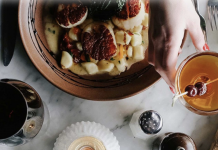The orange orbs that sport sinister expressions or perhaps the occasional cheerful grin for a few days this time of year are much more than a pretty face sitting on your doorstep. As part of the same gourd family as cucumbers, squash, and melons, pumpkin is high in fiber and a good source of beta-carotene (vitamin A), and potassium. Plus, the seeds are a deliciously nutty snack and rich in vitamins B and E—so don’t throw out the “guts” of those jack-o-lanterns this year. (See below on how to toast the seeds.)
The ones used for carving are just one branch of the pumpkin family. Their smaller relatives that may not be part of the party are often the workhorses that make not only the tasty pumpkin pie you look forward to every year but also a delicious array of food from savory to sweet. Pumpkin works equally well with spicy chiles, cumin, and turmeric as it does with warm spices such as cinnamon, nutmeg, and ginger or herbs such as sage and rosemary.
Fresh pumpkin can be easily cooked and puréed and used in any recipe from soups, stews, pasta, and side dishes to bread, muffins, and desserts. You can often use pumpkin interchangeably in recipes calling for squash, too. Just make sure you select the best type of pumpkin for the job.
There are basically two types of pumpkins available commercially—field pumpkins and sugar pumpkins. The field pumpkins are the kind used for jack-o-lanterns and are larger, a light shade of orange, and more suitable for carving. Their tough skin is hard to peel and their flesh is stringy and often watery with a very mild flavor—perfect for “guts” at a haunted house but not as flavorful as sugar pumpkins, which are smaller and best for cooking as they have a more flavorful, sweeter, less stringy, and tender flesh than the very large pumpkins.
Some sugar pumpkins to look for include those labeled “pie” pumpkins and fairytale, which has a thick skin, but its tender deep orange flesh is very light, sweet, thick, and firm. It has a distinctive Cinderella’s coach-like shape. Jack-be-Little—the little guys often used for decorations (pictured here)—is about the size of an orange, has a bright orange or white shell and sweet flesh.
Plan on purchasing 1/3 to ½ pound of pumpkin per serving if using as a side dish. (A lot of the weight will be discarded in the peel and seeds.) When using in recipes, figure a 5-pound pumpkin will yield about 4½ cups of mashed, cooked pumpkin. As comparison, if you’re used to canned pumpkin measurements, one 15- to 16-ounce can yields about 2 cups of mashed pumpkin.
Cook fresh pumpkin much the same way you do winter squash—either steam, bake, or microwave it. It’s best not to boil the pumpkin as it will soak up the water and make a watery purée (and subsequent pie, etc.).
To steam: Cut pumpkin in half and remove seeds and stringy pulp. Cut into smaller pieces and peel then place in a steamer or metal colander that will fit in a covered pot. Put over boiling water, cover, and steam for about 50 minutes or until tender. Mash and purée in a blender or food processor.
To bake: Heat oven to 350°F. Split pumpkin in half and remove seeds and stringy pulp. Place halves, cut side down, on a baking sheet and bake for about 1 hour or until tender when pierced with a fork. Spoon the soft pulp out of the shell and use in recipes or further process to create a purée.
To microwave: Cut in half and remove the seeds and stringy pulp. Wrap each half loosely in plastic wrap. Place the halves, cut side down on a microwave safe plate. Heat on high for about 7 minutes per pound or until tender. Spoon out the pulp and use in recipes or further process to create a purée.
If you plan to use the purée in a recipe that calls for canned pumpkin it’s a good idea to strain it. Line a strainer with coffee filters or cheesecloth then spoon the cooked pumpkin into the lined strainer. Place the strainer in a glass pie plate or large bowl to catch the drained liquid. Let it drain in the refrigerator for several hours or overnight.
Look for more pumpkin possibilities in upcoming posts. ’Tis the season, after all! Just let them give us an evil look—they can’t scare us away, we know they’re tasty!
Toasting Pumpkin Seeds
½ c. pumpkin seeds
1 tsp. melted butter or oil (olive or vegetable)
½ tsp. seasoning of your choice*
Clean the seeds by separating them from the stringy membrane of freshly carved pumpkin. Rinse the seeds in a colander until they are free of any membrane matter. Dry with paper towels.
Place cleaned and dried seeds in a bowl and toss with butter or oil and seasonings of choice. *(Salt is a classic and tasty choice but you can also experiment with garlic powder, curry mix, cayenne pepper, seasoning salt, a Cajun seasoning blend, cinnamon, or other spices.) Adjust the amount to your liking.
Preheat oven to 250°F.
Spread pumpkin seeds in a single layer on baking sheet. Bake for about 1 hour, stirring every 15 minutes, until they are golden brown. Store baked pumpkin seeds in an airtight container. To serve, it’s best to remove the white hull.






